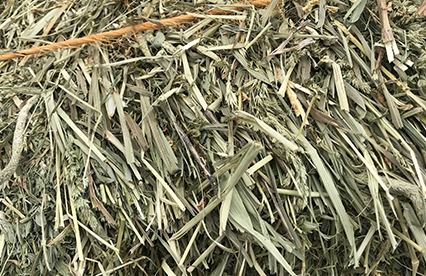FREE Holiday Shipping On All Orders!

Why test hay?
Posted on
This seems to be the big question when we talk to local hay producers. Often their response is something like, "So you want me to test this hay...why?" So if one of our local producers is unwilling to test their hay, we typically get a few samples and have it tested ourselves. If the hay looks super nice, like the first cutting crop this year, we'll take all we can get and figure out how to balance it later.
Here is one of the loads of hay we got earlier this summer. This is really nice hay. Here are several reasons why we love this hay:
1) This is an alfalfa grass mix. These mixes are not sprayed with weed killers because of the mix. There is a nice variety of nutrition from the mix of timothy, orchard and alfalfa. As you can see in the analysis, the NSC is only 8.2%. This is excellent and perfect for our QH buckskin Antonio who has PSSM, and our little easy keeper cutting mare, Reba. An NSC (Non-structural Carbohydrates) under 12% is recommended. To get an NSC%, you add the WSC (water soluble carbohydrates) + starch = NSC.
2) We love this hay because of the protein levels achieved mainly from the alfalfa. The 16.5% dry matter protein isn't too much for our all-adult crowd of horses, and especially our tends-to-get-tubby mare. Protein contains amino acids that are the building blocks for muscle function, including vital organs, skeletal, and connective tissue. Plus, we like to look at our horses' nice coats and hooves which are achieved from good protein intake.
3) We love that this is a first-cutting hay. Typically 1st cutting hay tends to have an over all better nutritional level from the roots having from last fall until May to soak up nutrients from the ground. In most areas where hay is grown, spring provides moisture, which tends to inhibit starch levels from getting too high. Clover typically hasn't taken over, and neither have weeds.
4) The calcium to phosphorus to magnesium ratios. Calcium needs to be 1.2 to 2, up to 6 times higher than phosphorus, for skeletal functions, along with many other functions. Magnesium aids in the absorption of calcium, as well as muscle contraction regulation. Magnesium also aids in lowering circulating insulin levels.
We send our hay samples into Equi-Analytical, located in Ithaca, NY.
Our horses typically receive 1/2 to 1/4 of their daily forage intake with this hay. They also forage in the pasture and also have a much lower quality grass hay available to them.
Feeding a high quality alfalfa mix that is low in NSC (8.2%) can be ideal for many horses. The key is in testing your hay to make sure your NSC levels are within normal limits, and below 12% if your horse is sensitive.
Get In Touch
Email us anytime at
Lenny@savvyhorseproducts.com
Or call us at 937-RU-SAVVY (937-787-2889)


Leave a comment: